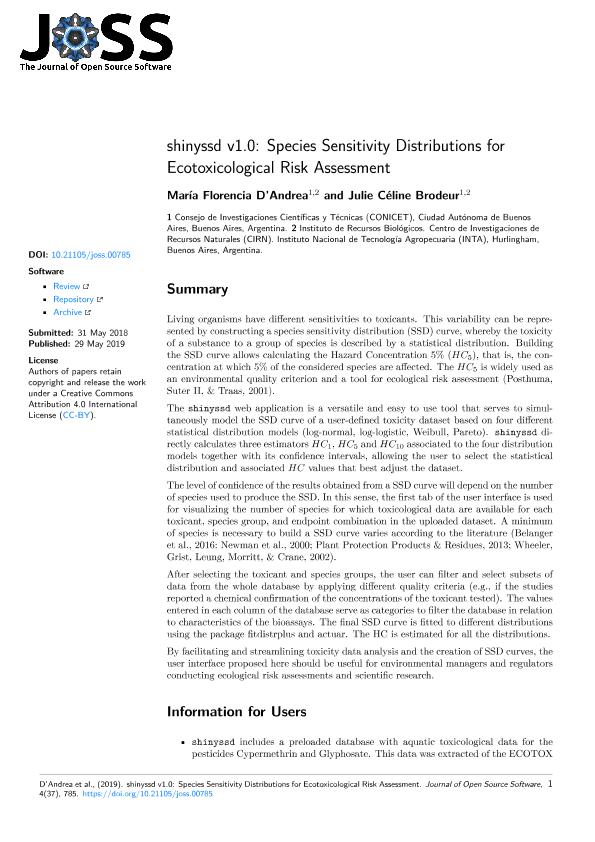Mostrar el registro sencillo del ítem
dc.contributor.author
D'andrea, María Florencia

dc.contributor.author
Brodeur, Celine Marie Julie

dc.date.available
2021-04-14T02:22:51Z
dc.date.issued
2019-05
dc.identifier.citation
D'andrea, María Florencia; Brodeur, Celine Marie Julie; shinyssd v1.0: Species Sensitivity Distributions for Ecotoxicological Risk Assessment; The journal of open science software; Journal of Open Source Software; 4; 37; 5-2019; 1-3
dc.identifier.issn
2475-9066
dc.identifier.uri
http://hdl.handle.net/11336/129985
dc.description.abstract
Living organisms have different sensitivities to toxicants. This variability can be represented by constructing a species sensitivity distribution (SSD) curve, whereby the toxicityof a substance to a group of species is described by a statistical distribution. Buildingthe SSD curve allows calculating the Hazard Concentration 5% (HC5), that is, the concentration at which 5% of the considered species are affected. The HC5 is widely used asan environmental quality criterion and a tool for ecological risk assessment (Posthuma,Suter II, & Traas, 2001).The shinyssd web application is a versatile and easy to use tool that serves to simultaneously model the SSD curve of a user-defined toxicity dataset based on four differentstatistical distribution models (log-normal, log-logistic, Weibull, Pareto). shinyssd directly calculates three estimators HC1, HC5 and HC10 associated to the four distributionmodels together with its confidence intervals, allowing the user to select the statisticaldistribution and associated HC values that best adjust the dataset.The level of confidence of the results obtained from a SSD curve will depend on the numberof species used to produce the SSD. In this sense, the first tab of the user interface is usedfor visualizing the number of species for which toxicological data are available for eachtoxicant, species group, and endpoint combination in the uploaded dataset. A minimumof species is necessary to build a SSD curve varies according to the literature (Belangeret al., 2016; Newman et al., 2000; Plant Protection Products & Residues, 2013; Wheeler,Grist, Leung, Morritt, & Crane, 2002).After selecting the toxicant and species groups, the user can filter and select subsets ofdata from the whole database by applying different quality criteria (e.g., if the studiesreported a chemical confirmation of the concentrations of the toxicant tested). The valuesentered in each column of the database serve as categories to filter the database in relationto characteristics of the bioassays. The final SSD curve is fitted to different distributionsusing the package fitdistrplus and actuar. The HC is estimated for all the distributions.By facilitating and streamlining toxicity data analysis and the creation of SSD curves, theuser interface proposed here should be useful for environmental managers and regulatorsconducting ecological risk assessments and scientific research.
dc.format
application/pdf
dc.language.iso
eng
dc.publisher
The journal of open science software
dc.rights
info:eu-repo/semantics/openAccess
dc.rights.uri
https://creativecommons.org/licenses/by/2.5/ar/
dc.subject
R
dc.subject
ECOTOXICOLOGICAL RISK ASSESSMENT
dc.subject
SHINY APP
dc.subject
TOXICOLOGY
dc.subject
ENVIRONMENTAL MANAGMENT
dc.subject.classification
Otras Ciencias de la Computación e Información

dc.subject.classification
Ciencias de la Computación e Información

dc.subject.classification
CIENCIAS NATURALES Y EXACTAS

dc.title
shinyssd v1.0: Species Sensitivity Distributions for Ecotoxicological Risk Assessment
dc.type
info:eu-repo/semantics/article
dc.type
info:ar-repo/semantics/artículo
dc.type
info:eu-repo/semantics/publishedVersion
dc.date.updated
2021-03-25T13:41:59Z
dc.journal.volume
4
dc.journal.number
37
dc.journal.pagination
1-3
dc.journal.pais
Estados Unidos

dc.description.fil
Fil: D'andrea, María Florencia. Instituto Nacional de Tecnología Agropecuaria. Centro de Investigación de Recursos Naturales; Argentina. Consejo Nacional de Investigaciones Científicas y Técnicas; Argentina
dc.description.fil
Fil: Brodeur, Celine Marie Julie. Instituto Nacional de Tecnología Agropecuaria. Centro de Investigación de Recursos Naturales; Argentina. Consejo Nacional de Investigaciones Científicas y Técnicas; Argentina
dc.journal.title
Journal of Open Source Software
dc.relation.alternativeid
info:eu-repo/semantics/altIdentifier/doi/https://doi.org/10.21105/joss.00785
dc.relation.alternativeid
info:eu-repo/semantics/altIdentifier/url/https://joss.theoj.org/papers/10.21105/joss.00785
Archivos asociados
